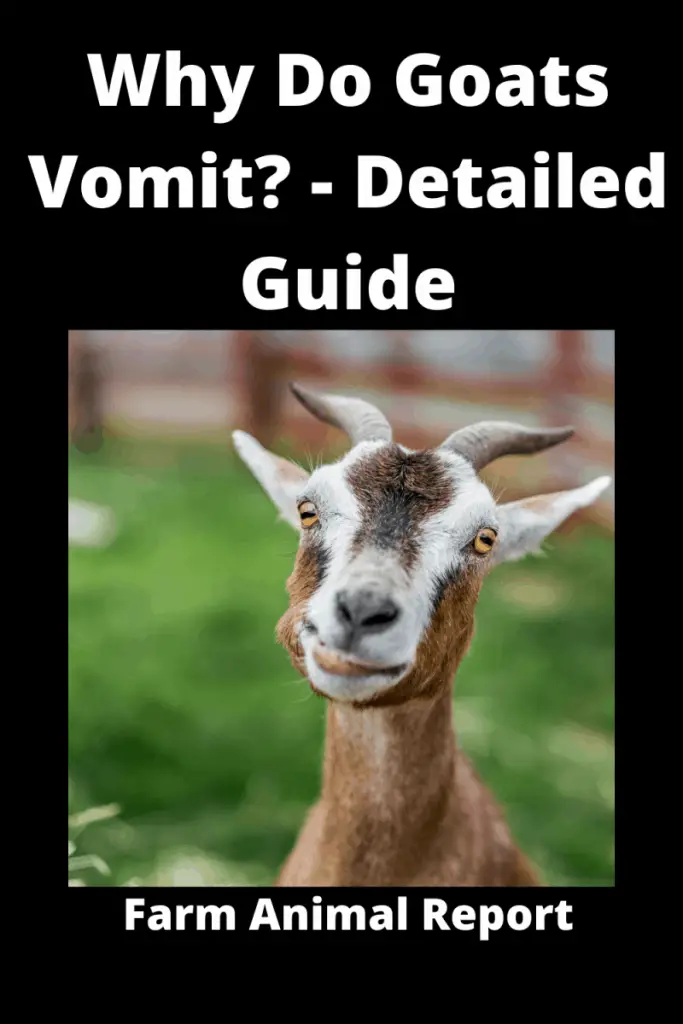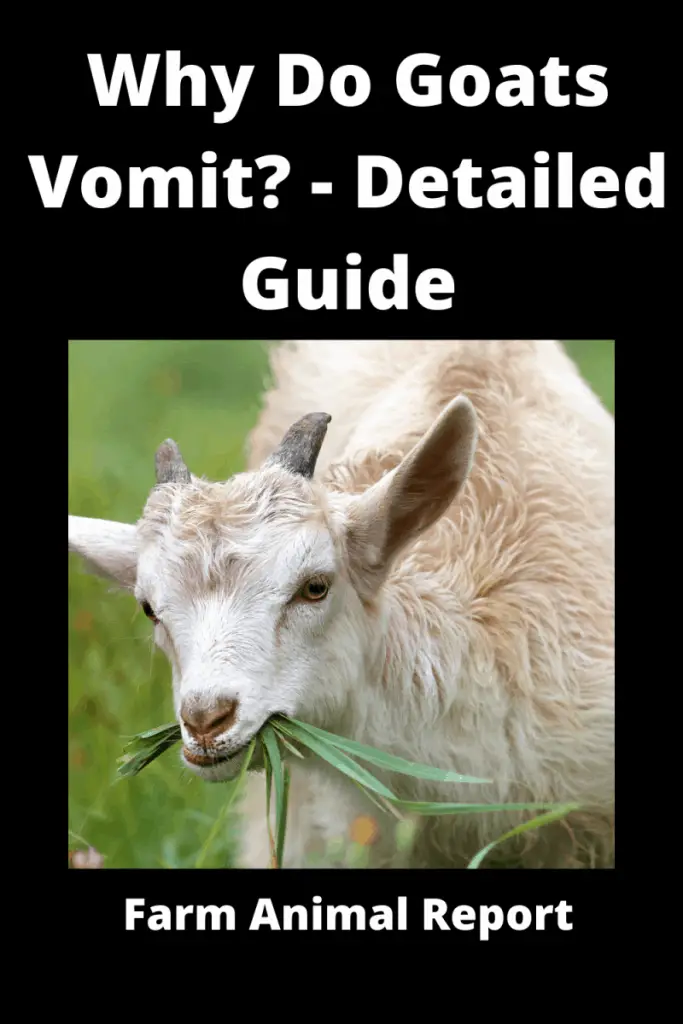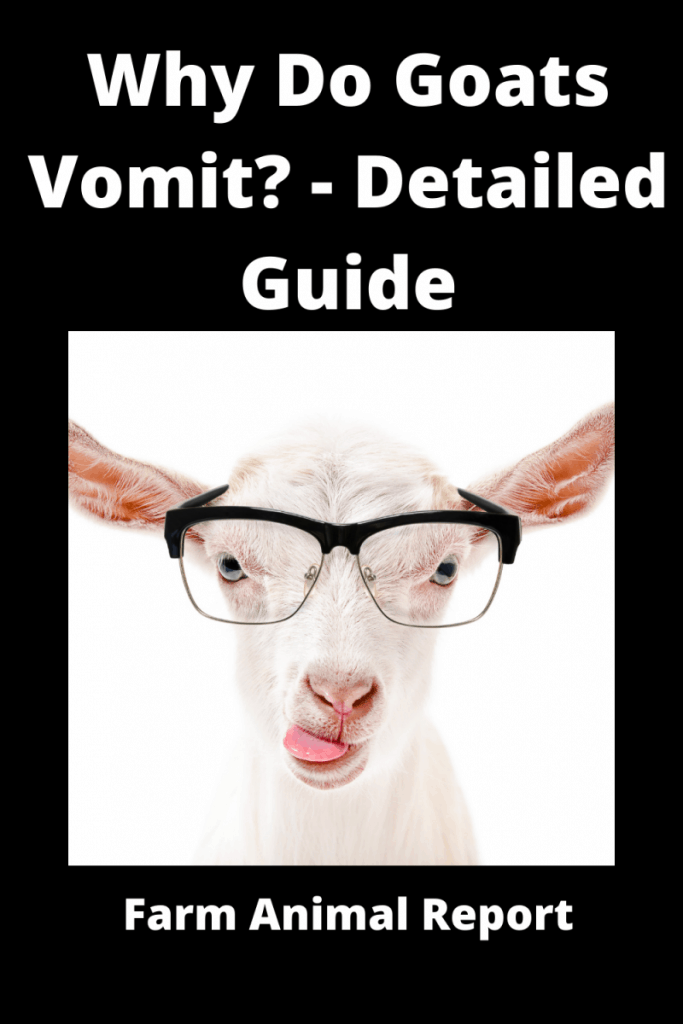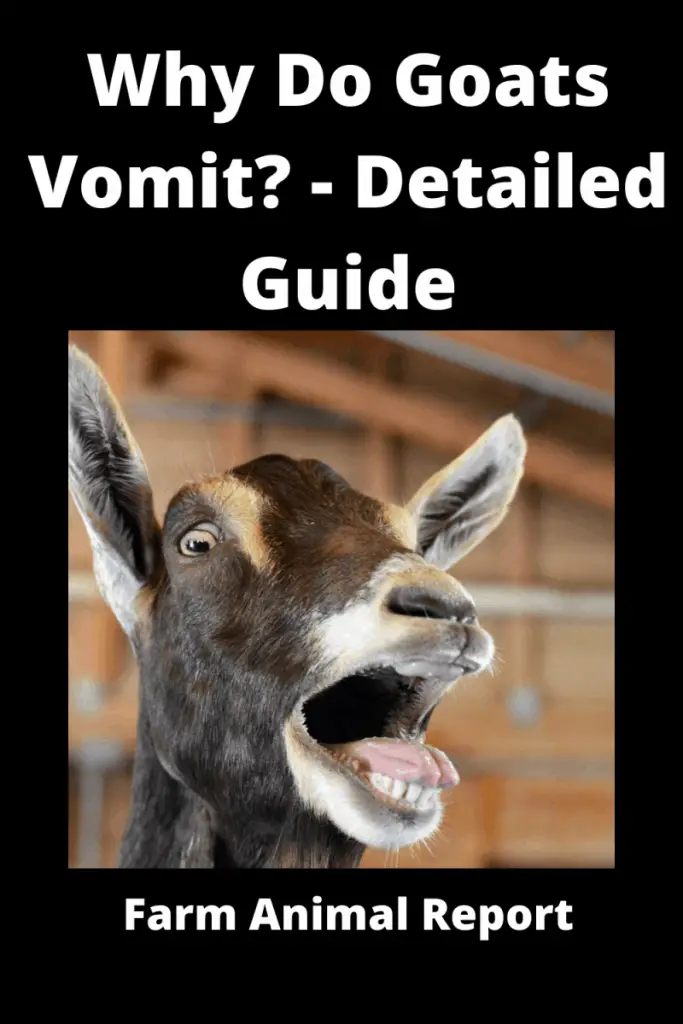Why Do Goats Vomit. Before going towards the reason behind the vomiting, you should know what is vomiting.
Why are My Goats Throwing Up
Vomiting is the reflexive, forceful expulsion of part or all of the stomach’s contents and proximal small intestines through the mouth. It involves a series of involuntary spasmic movements requiring visceral, diaphragmatic, and abdominal muscular contractions. The act of vomiting is usually preceded by several stereotypical prodromal clinical signs, including excessive salivation, retching, and marked contraction of the abdominal musculature. Why are My Goats Throwing Up

Vomiting must be differentiated from regurgitation, dysphagia, and various forms of esophageal dysfunction. Regurgitation is a passive process whereby partially or completely undigested food or liquid is released from the esophagus and stomach through the mouth without effort or muscular contractions. Why is My Goats Vomiting?
Check Out Amazon for Resources on Understanding Goat Diseases
Although dysphagia involves active but ineffective muscular contractions and may produce movements that closely resemble the retching associated with vomiting, the process represents a dysfunctional movement of liquid and food into, not out of the GI tract.
What is the Reason Behind the Vomiting?
- The reflex act of vomiting is initiated by the vomiting center, located in the reticular formation of the medulla.
- The vomiting center is responsive to input from 4 major sources:
- Afferent receptors from a variety of outer structures (the GI tract, pancreas, heart, liver, urogenital tract, and peritoneum) carried by the vagus and sympathetic nerves.
- The chemoreceptor trigger zone (CRT) of the area postman of the medulla
- The cerebral cortex and limbic system
- The vestibular apparatus.

Causes of Vomiting:
- Increase in intracranial pressure
- Distension of the duodenum or colon
- Organ capsule distension or inflammation
- Blood born toxins ( exogenous chemotherapeutics or endogenous uremic toxins)
- Toxins (pesticides, zinc, xylitol, mycotoxins)
- Plant toxins
- Envenomation
- Parasites
- Inflammation (pancreatitis)
- Drugs (acyclovir, cisplatin, piperazine)
- Neoplasia
- Enterotoxemia
Goats Ingest Plant Toxins(Azaleas)
Azaleas contain a toxin called grayanotoxin, and it is potent. Fresh foliage ingested at even just 0.1% of a goat’s body weight is enough to make the animal sick that means that just 0.1 pounds to a 100-pound animal. If you know goats, you know they can munch far more than that in a very short space of time.
Once ingested, azaleas cause intense stomach pain and bloating. Usual causes of azalea toxicity you will see involve a group of very miserable goats that appear to be having the worst tummy aches of their lives. Often, toxicity is accompanied by vomiting.
See Our Guide – 8 Ways to Make Money from Goat Farming
Azalea toxicity can be fatal. The toxin can affect the heart, leading to rhythm disturbance, neurologic impairment can also occur, followed by convulsions and death. This is influenced mostly by how much the goat has consumed.
The goat owners have azaleas around their home or are born for decoration and are not aware they are toxic to goats, or well-meaning neighbor has dumped hedge clippings into the goat pasture for the goats to munch on, not knowing the clippings contain azalea toxicity.
Although clinical signs and testimonies from witnesses who have seen the goats eating toxic shrubs are the most common clues to the cause of the sick goats, you will occasionally have a case where you are not sure azaleas are to blame.
Diagnosis of Azaleas:
When you want to confirm the case of azaleas, you should go for the laboratory tests that can be run on urine or feces to detect the presence of grayanotoxin to confirm a diagnosis.

What is the Antidote for Azaleas?
- There is no antidote for the toxic compound in azaleas; supportive care is your only option. Bismuth subsalicylate or activated charcoal can coat the stomach and prevent further absorption of the toxin.
- IV fluids are also usually given because the sick animals are likely dehydrated and sometimes shock.
- Continued hydration with electrolytes should be performed, and when vomiting is finished, yogurt with live cultures can be given orally to restore gut flora.
Plant toxins (Rhododendron poisoning) in goat:
Rhododendron poisoning may occur in goat. Rhododendron belongs to the Ericaceae family. There are at least 250 species of rhododendrons found mostly in the acidic soils of western and eastern North America.
Rhododendron Toxic Principle:
All parts of the plant, including the nectar, contain grayanotoxins. Most poisoning occurs in the winter months because the leaves are generally evergreen and are attractive to animals when another forage is scarce. Animals eating approximately 0.2 percent of their body weight of leaves are likely to develop signs of poisoning.
Generally, large shrubs or open trees growing to heights of 30 feet or more. The leaves are alternate, simple, leathery, lanceolate, and often evergreen. The flowers are produced in large, showy, terminal clusters, ranging in color from white to purple, to red. The fruits are elongated capsules that split into five sections to release small, scale-like seeds.
Clinical Signs of Rhododendron Poisoning:
There are the following clinical signs:
Gastrointestinal signs:
Animals poisoned by rhododendrons initially have clinical signs of digestive disturbances characterized by anorexia, excessive salivation, vomiting, colic, and frequent defecation.
Treatment of Rhododendrons Concerning the Gastrointestinal Issues:
- Oral and intravenous fluids should be given as necessary to counteract the effects of vomiting and diarrhea.
- Cardiovascular system signs:
- In severe cases, muscle weakness, bradycardia, cardiac arrhythmia, weakness, paralysis, and coma may precede death.
- Respiratory system signs:
- Regurgitation of rumen contents may result in inhalation pneumonia.
Reproductive signs:
Fetal mummification has been reported in goats.
- The clinical signs and evidence that the plant has been consumed are highly suggestive of rhododendron poisoning. The detection of grayanotoxins in the rumen contents is also rhododendron poisoning.
Public Health Concern:
Depression, vomiting, slow, erratic heart rate, painful neck, and weakness are reported in people who have consumed “Mad honey” made by bees feeding on rhododendrons. Rhododendrons are not appropriate shrubs to plant around or livestock enclosures where the animals can gain access to the plants.
Antidotes of Rhododendron Poisoning:
There are different kinds of the recipe for Rhododendron poisoning:
Irene’s recipe for Rhododendron poisoning:
There is the following recipe for Rhododendron poisoning:
Ingredients:
- 15ml Renco
- 15ml milk of magnesia
- 5ml brandy
- Mix all together
Renco is good for a variety of gastric ailments in goats, and it works even when it is well past, so don’t chuck it out just because you can’t use it for junket or cheese anymore.
Milk of Magnesia is useful for Several Stomach Upsets in Goats.
Its action is twofold: It puts a lining on the gut and regulates the pulsing of the gut, which often gets out of kilter with poisoning or colic.
Lorraine’s Recipe for Rhododendron poisoning:
Ingredients:
Quantities do not need to be too exact.
- ¼ cup cooking oil
- ½ cup strong/strong cold tea (6 to 8 tea bags removed)
- One teaspoon ground ginger
- I teaspoon baking soda
- Mix all together and drench the goat with it all.
Oil puts a lining on the stomach preventing more poison going into the system, tea is the antidote, and ginger relieves pain; baking soda helps bring up the gas.
How Can We Treat the Vomiting in Goat as a General Point of View?
The primary goal of treatment in a vomiting patient is to identify and treat the vomiting’s underlying cause. Obtaining a definitive diagnosis before instituting symptomatic treatment is almost always a prudent and frequently cost-effective approach in any vomiting patient.
Antiemetic therapy is an essential component of the plan for many vomiting patients, but with the administration of an antiemetic, the clinician losses the ability to correlate the cessation of vomiting to any other specific parameter (rehydration, resolution of partial obstruction, effective treatment of an underlying disease process, the natural progression of simple gastritis).
Symptomatic therapy for acute vomiting includes withholding food for 24 hr. Water should never be withheld unless the animal is receiving SC or IV fluid support.
Predictable consequences of vomiting include dehydration, electrolyte imbalances, and acid-base disturbance; withholding water without appropriately addressing the patient’s hydration status will exacerbate and compound these abnormalities. Some animals show a positive response to this 24-hr intervention, and small volumes of oral liquid, and eventually food, can be slowly reintroduced without further vomiting episodes.
Results of Vomiting:
- Many vomiting animals require a more extensive period of aggressive rehydration tailored to the progression or resolution of abnormalities in electrolytes and acid-base status.
- Vomiting often results in prerenal azotemia, hypokalemia, hypochloremia, metabolic alkalosis, and paradoxical aciduria due to losses of secretions rich in potassium and chlorine and hydrogen.
- Persistent vomiting without sufficient rehydration can result in metabolic acidosis and loss of base excess, hypovolemia, poor tissue perfusion, hypoxia, and lactic acidosis. Therefore, it is difficult to predict the acid-base/electrolyte status of a vomiting animal, and the clinician’s ability to address this imbalance depends on a repeated assessment of a variety of parameters.
- The decision to institute antiemetic therapy is based on the animal’s clinical presentation, identification of underlying causes, need to assess the natural progression of the animal’s condition, response to other treatments, and overall impact of the vomiting on the patient’s emotional, physical, and biochemical status. Many antiemetics are available, and their effectiveness is often a function of which and how many of the previously describe inputs to the vomiting center the target. Antiemetics that are particularly efficient in animals with vestibular disease may be of little help to animals whose vomiting is secondary to renal failure.

Drugs that are Used for the Treatment of Vomiting:
- Drugs that act directly on the vomiting center include the phenothiazine tranquilizers such as prochlorperazine (0.3mg/kg, PO, bid; 0.1 mg/kg, IM, qid; or 0.1-0.5 mg/kg, SC, tid) and chlorpromazine (0.5 mg/kg, PO, qid; 0.5 mg/kg, IM, tid; or 1 mg/kg, rectally, tid).
- Phenothiazine agents also inhibit the activity of the CRTZ and have weak anticholinergic effects, making them a particularly powerful and effective choice in many animals. Although the antiemetic effects are seen at dosages lower than those required for tranquilization, hypotension is potentially adverse. Thus, animals must be adequately rehydrated before instituting phenothiazine therapy.
- A new class of antiemetic that appears to work at both the vomiting center and the CRTZ is the NK-1 receptor antagonist maropitant (1mg/kg SC, once daily for up to 5 days; 2mg/kg PO, once daily for up to 5days; 8mg/kg PO, once daily for up to 2 days for motion sickness. The maropitant administration includes a washout period (5 days on/2 days off for vomiting; 2 days on/3 days off for motion sickness). Mild, transient discomfort following SC injection may occur in some animals.
- Dopaminergic antagonists such as metoclopramide (0.2-0.5 mg/kg, PO or SC, qid, or 1-3 microgram/kg/min constant-rate infusion act at the level of the CRTZ and peripheral receptors and are considered useful in the management of vomiting secondary to a variety of causes.
- Ondansetron (0.1-1 mg/kg, PO, once to twice daily, or 30 min before chemotherapy; 0.11-0.18 mg/kg, IV) is a potent antiemetic agent acting as a selective 5-HT3 serotonin-receptor antagonist with both central and peripheral activity. The peripheral release of serotonin has been shown to play an important role in the vomiting response to chemotherapeutic administration, and ondansetron should be considered in cancer patients prior to therapy as well as other cases unresponsive to other antiemetic agents.
- Similar to ondansetron, dolasetron (0.6-1.0 mg/kg, IV or PO, once daily) is a serotonin 5-HT3 antagonist used to reduce nausea and to vomit secondary to anesthesia, chemotherapy, enteritis, and renal and hepatic disease.
Goat Breeder Associations
| Goat Association | Location | Link |
|---|---|---|
| American Goat Breeders Association | United States | AGF |
| English Goat Breeders Association | UK | EGBA |
| Canadian Meat Goat Association | Canada | CMG |
| Minature Goat Breeders Association | Australia | MGBA |
| Boer Goats | South Africa | BGSA |
| American Boer Goat Association | United States | ABGA |
| World Goat Breeders Associations | List | WGBA |





